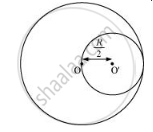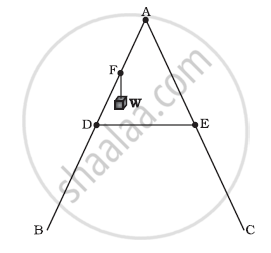Advertisements
Advertisements
प्रश्न
From a uniform disk of radius R, a circular hole of radius R/2 is cut out. The centre of the hole is at R/2 from the centre of the original disc. Locate the centre of gravity of the resulting flat body.
उत्तर १
R/6; from the original centre of the body and opposite to the centre of the cut portion.
Mass per unit area of the original disc = σ
Radius of the original disc = R
Mass of the original disc, M = πR2σ
The disc with the cut portion is shown in the following figure:

Radius of the smaller disc = `R/2`
Mass of the smaller disc, M’ = `pi(R/2)^2 sigma = 1/4piR^2 sigma = M/4`
Let O and O′ be the respective centres of the original disc and the disc cut off from the original. As per the definition of the centre of mass, the centre of mass of the original disc is supposed to be concentrated at O, while that of the smaller disc is supposed to be concentrated at O′.
It is given that:
`OO' = R/2`
After the smaller disc has been cut from the original, the remaining portion is considered to be a system of two masses. The two masses are:
M (concentrated at O), and -M(`=M/4`)Concentrated at O'
(The negative sign indicates that this portion has been removed from the original disc.)
Let x be the distance through which the centre of mass of the remaining portion shifts from point O.
The relation between the centres of masses of two masses is given as:
`x = (m_1r_1 + m_2r_2)/(m_1+m_2)`
For the given system, we can write:
`x = (Mxx0-Mxx(R/2))/(M+(-M'))`
=`(-M/4 xxR/2)/(M - M/4) = (-MR)/8 xx 4/(3M) = -R/6`
(The negative sign indicates that the centre of mass gets shifted toward the left of point O.)
उत्तर २
Let from a bigger uniform disc of radius R with centre O a smaller circular hole of radius R/2 with its centre at O1(where R OO1 = R/2) is cut out. Let centre of gravity or the centre of mass of remaining flat body be at O2, where OO2 = x. If σ be mass per unit area, then mass of whole disc M1 = πR2σ and mass of cut out part
`M_2 = pi(R/2)^2 sigma = 1/4piR^2 sigma = M_1/4`
`x = (M_1xx(0) - M_2(OO_1))/(M_1-M_2) = (0 - M_1/4 xx R/2)/(M_1 - M_1/4) = -R/6`
i.e., O2 is at a distance R/6 from centre of disc on diametrically opposite side to centre of hole
APPEARS IN
संबंधित प्रश्न
A car weighs 1800 kg. The distance between its front and back axles is 1.8 m. Its centre of gravity is 1.05 m behind the front axle. Determine the force exerted by the level ground on each front wheel and each back wheel.
A metre stick is balanced on a knife edge at its centre. When two coins, each of mass 5 g are put one on top of the other at the 12.0 cm mark, the stick is found to be balanced at 45.0 cm. What is the mass of the metre stick?
As shown in Fig.7.40, the two sides of a step ladder BA and CA are 1.6 m long and hinged at A. A rope DE, 0.5 m is tied half way up. A weight 40 kg is suspended from a point F, 1.2 m from B along the ladder BA. Assuming the floor to be frictionless and neglecting the weight of the ladder, find the tension in the rope and forces exerted by the floor on the ladder. (Take g = 9.8 m/s2)
(Hint: Consider the equilibrium of each side of the ladder separately.)

If the sum of all the forces acting on a body is zero, is it necessarily in equilibrium? If the sum of all the forces on a particle is zero, is it necessarily in equilibrium?
A uniform ladder of length 10⋅0 m and mass 16⋅0 kg is resting against a vertical wall making an angle of 37° with it. The vertical wall is frictionless but the ground is rough. An electrician weighing 60⋅0 kg climbs up the ladder. If he stays on the ladder at a point 8⋅00 m from the lower end, what will be the normal force and the force of friction on the ladder by the ground? What should be the minimum coefficient of friction for the electrician to work safely?
Suppose the friction coefficient between the ground and
the ladder of the previous problem is 0.540. Find the
maximum weight of a mechanic who could go up and do
the work from the same position of the ladder.
The door of an almirah is 6 ft high, 1⋅5 ft wide and weighs 8 kg. The door is supported by two hinges situated at a distance of 1 ft from the ends. If the magnitudes of the forces exerted by the hinges on the door are equal, find this magnitude.
A rod of weight W is supported by two parallel knife edges A and B and is in equilibrium in a horizontal position. The knives are at a distance d from each other. The centre of mass of the rod is at distance x from A. The normal reaction on A is
The centre of gravity of a body on the earth coincides with its centre of mass for a ‘small’ object whereas for an ‘extended’ object it may not. What is the qualitative meaning of ‘small’ and ‘extended’ in this regard? For which of the following the two coincides? A building, a pond, a lake, a mountain?
The vector sum of a system of non-collinear forces acting on a rigid body is given to be non-zero. If the vector sum of all the torques due to the system of forces about a certain point is found to be zero, does this mean that it is necessarily zero about any arbitrary point?
